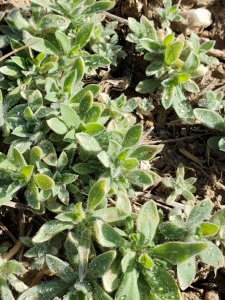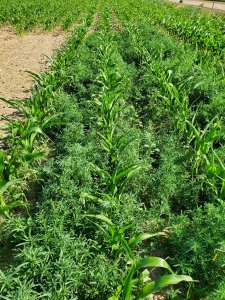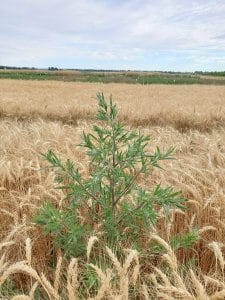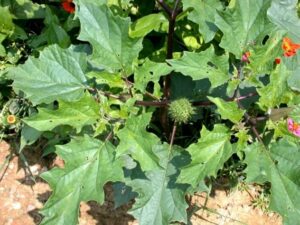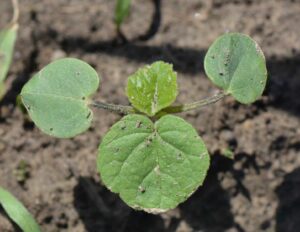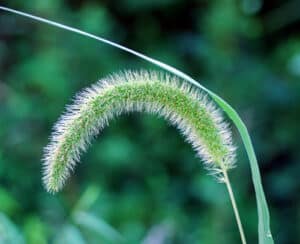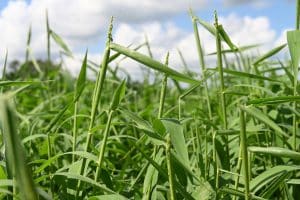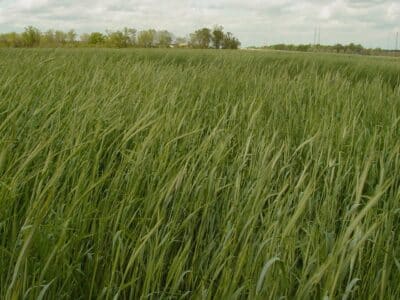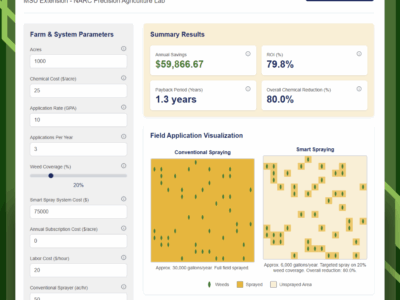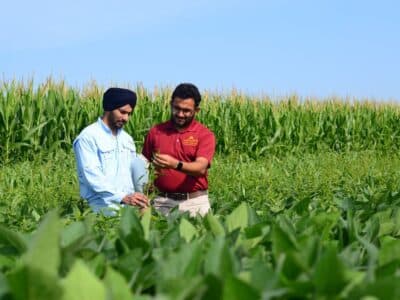Bassia scoparia L. Formerly Kochia scoparia
Also known as: Burning bush, mock-cypress, Mexican firebush, Mexican fireweed.


Biology
The biology of kochia is particularly problematic because of its ability to emerge in early-spring, grow rapidly, and tolerate heat, drought, and saline soil conditions. The spread of kochia, including widespread herbicide-resistant biotypes, is facilitated by obligate outcrossing and tumbleweed physical seed dispersal mechanisms. Small emerging kochia seedlings have leaves that are densely covered in small, fine, white hairs in what is commonly referred to as the button stage. Herbicide applications during button stage are discouraged (as often stated on herbicide label) as leaf hairs can reduce foliar absorption of herbicides by suspending droplets above the leaf cuticle on the leaf hairs.

Around two weeks after seedling emergence, leaf hair density decreases as leaves grow. After the button stage, kochia leaves maintain fine leaf hairs on the bottom of the leaf, while leaf tops are smooth. It is common to see high seedling densities, especially around the location where the parent plant was growing before detaching from the soil when mature. This is often referred to as a “kochia mat.”
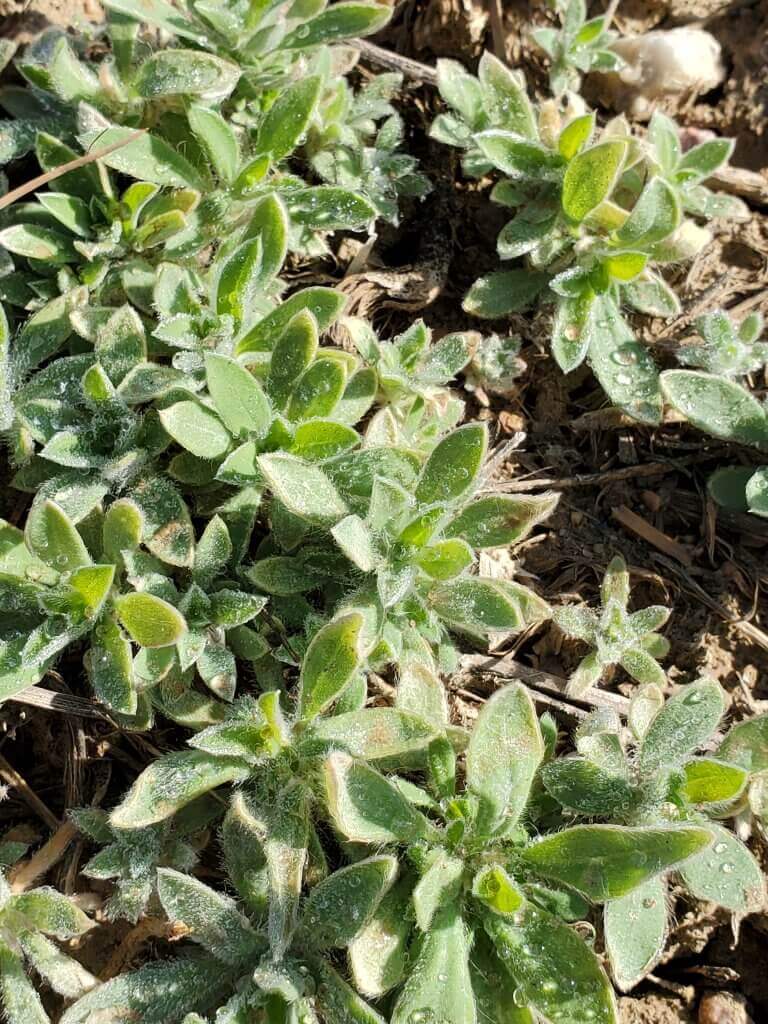
Kochia leaves are alternate with simple blades that are highly pubescent and arise on erect, highly branched stems. Kochia flowers are inconspicuous without petals, and on a given flower the stigmas emerge prior to anther development which facilitates cross pollination between plants. Flowers develop in clusters in the axils of upper leaves and in terminal spikes. Seeds are around 1.5 mm long and develop in star shaped fruit that are brown and flattened. Kochia has a shallow taproot which can be easily pulled or hoed out at early growth stages. Once fully matured, an abscission layer near the soil surface allows for whole plants to detach and bounce across the landscape dropping seed in a wind-driven process known as ‘Tumble mechanism’.
Kochia is a summer annual broadleaf weed species native to Eurasia and was introduced to the Americas as an ornamental in the mid to late 1800s by European immigrants. Ornamental kochia escaped cultivation and formed naturalized populations that now occur throughout most of the continent, especially in arid and semiarid environments. The ability to grow in dry, saline soils has led to adaptation and widespread distribution of kochia in the arid west and semi-arid Great Plains.
Kochia growth and architecture is highly influenced by inter and intraspecific competition. When growing with competing vegetation, growth is more erect, single stemmed and taller; when growing in the absence of competing vegetation, it is more bushy and multi-branched with a larger plant diameter. In moderately dense kochia stands that promote erect, taller primary axis growth, plants can get over six feet tall. While in low competition environments high light intensity suppresses apical dominance and lateral growth resulting in plants typically around three feet tall with oval growth forms and a diameter similar to its height.
Where is kochia a problem?
Kochia is common in rangeland, pastures, and crop production systems where it has adapted and thrives in semiarid to arid regions of North America. It is also commonly found along roadsides, ditch banks, railroad tracks, and in other disturbed sites as a ruderal species. Kochia is competitive in cropping systems due to its ability to germinate and emerge early at low soil temperatures, grow rapidly, and tolerate heat, drought, and saline soil conditions. In areas at high risk of saline seep development, dense kochia patches are a common indicator of increasing soil salinity in crop fields. With further herbicide-resistance development, kochia is becoming more problematic in chemical-fallow fields.
What is the emergence pattern of kochia?
Kochia has a wide window of emergence due to the unique ability to germinate at low temperatures as early as January and continue to emerge throughout the summer into July. High seedling emergence in early spring and continued emergence into mid or late-summer means kochia must be managed from early spring through late summer. Kochia seed does not generally exhibit innate dormancy so mature seeds are readily germinable and will germinate rapidly under favorable conditions, prolonging the emergence period.
What is the lifecycle of a kochia plant like?
Kochia can germinate in low temperatures early in the spring with emergence extending into July. Kochia will grow vegetative throughout the spring and summer before flowering; it can produce copious amounts of pollen. In the fall, fully senesced mature kochia plants will detach at the soil surface and tumble across the landscape, dropping seeds with each impact, in a wind-driven process that spreads seeds long distances.
Example graph:
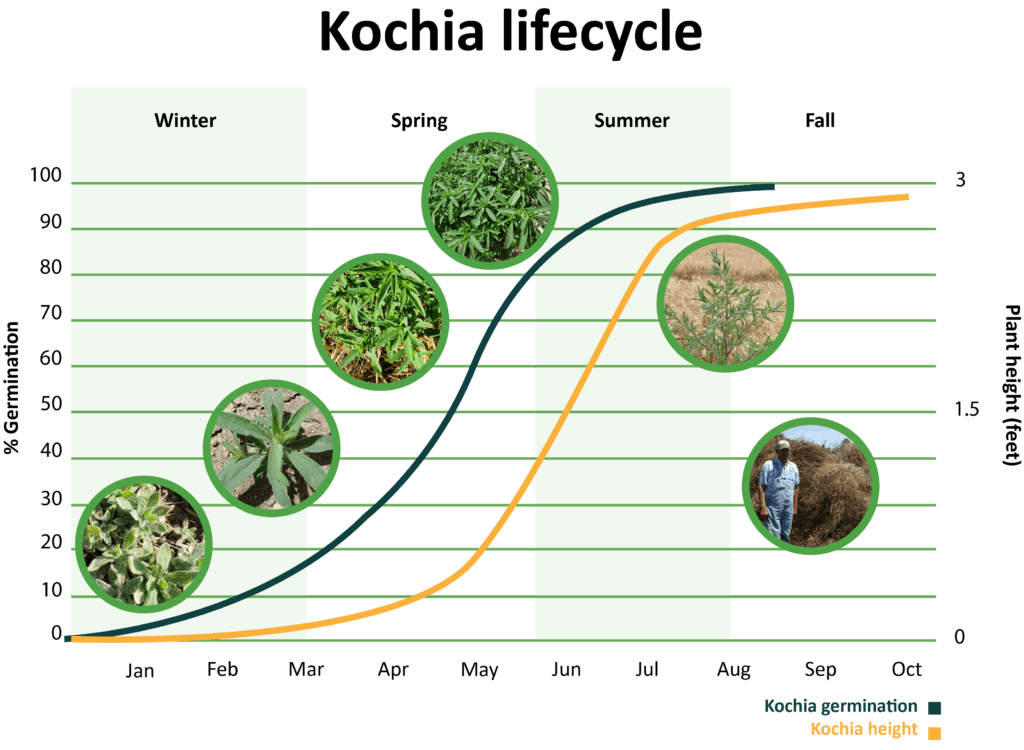
How does kochia spread?
Kochia physically spreads seeds via a tumbling mechanism where the senesced (mature) plant’s stem breaks at the soil surface, which allows the plant to roll across the landscape in the fall dropping seed along the way in a wind-driven process. Studies have shown that kochia tumbleweeds can move up to 3,280 feet (plants were stopped at fence line at this distance), and pollen from kochia can move up to 315 feet, allowing for the rapid physical spread and genetic exchange between individuals.
How many seeds can kochia produce and how long can those seeds survive?
Kochia is a prolific seed producer. Seed production per plant can vary widely depending on stand density and the extent of intra- and interspecific competition. Seed production of field-grown kochia has been shown to range from 2,000 to 30,000 seeds per plant, with an average of around 14,000 seeds per plant. More recent evaluations of seed production from kochia growing in sugarbeets have shown that individual kochia plants can produce over 100,000 seeds per plant. Kochia seed is relatively short lived in the soil with a mean seed bank longevity of 1-2 years. Kochia seedlings typically cannot emerge from greater than two inches deep in the soil.
What other biological weaknesses does kochia have that can be targeted with management techniques?
The weakest points in a kochia plant’s life cycle are the seed and seedling growth stage. The seeds are short-lived and germinate rapidly under favorable conditions in the top two inches of the soil. Management efforts should focus on suppressing weed seed germination and seedling emergence through strategic tillage, preemergence (PRE) herbicides, and competitive crops. The wind-driven tumbleweed dispersal mechanism allows the use of fence lines or physical barriers to minimize the movement of kochia between fields, although an extensive build up of kochia tumbleweeds on fences can occur. Planting a few rows of a stiff stemmed crop like corn or sorghum along field borders of the prevailing winds can help prevent kochia tumbleweeds from dispersing their seeds in the field. An unharvested strip of small grains can be left as a kochia barrier, too, though it is not as effective as corn.
Herbicide Resistance
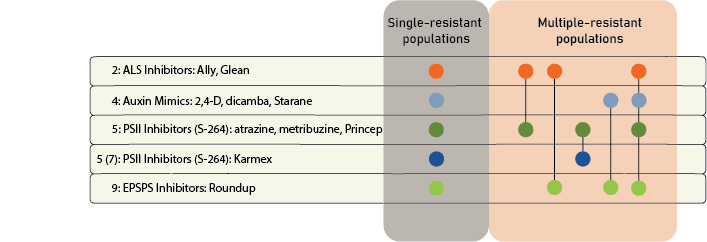
Contact your local extension office for details about resistance in your area and management options.
*Herbicide names listed are representative products that contain specific active ingredients. Last updated on: 8-10-2020
Integrated Weed Management Strategies
Cultural Tactics: Focusing on control of emerged seedlings prior to planting through strategic shallow-tillage (e.g. Undercutter/V-blade) to remove germinated seedlings where acceptable can help manage early emerging kochia. Establishing competitive crops using optimum planting dates, row spacing, seeding rates, and competitive varieties that close their canopy faster can help crops to compete with kochia, especially during early critical weed free periods. Establishing competitive crops such as winter wheat has been shown to reduce kochia biomass in field studies by over 99% compared to treatments without wheat. Mowing kochia closer to flowering has been shown to reduce seed densities the following year by 98% and reduce biomass by 33% compared to a non-mowed control in a surface mining reclamation project. Chemical fallow is commonly used in the high plains, however the development of herbicide-resistance to commonly used fallow herbicides allows for maximum kochia growth and seed production in the absence of plant competition. Kochia that are able to grow in chemical fallow can rapidly spread a resistance trait through both seed and pollen dispersal. Resistance to glyphosate (RoundUp) is commonly seen in chemical fallow with the meandering trails of kochia throughout the field

Cover Crops: Fall-sown cover crops can compete with both late-fall and early-spring emerging kochia to help minimize kochia growth and biomass production. Fall-sown triticale has been shown to reduce kochia densities by 78 to 94% and biomass by 98% compared with kochia in chemical fallow. Because kochia and spring-planted cover crops both germinate at the same time in early spring, spring-planted cover crops are not effective at reducing kochia densities or biomass. This emphasizes the value of fall-sown cover crops for kochia suppression. Fall-sown cover crops that produce the most biomass are most effective at suppressing kochia. However, evaluation of cover crops for weed suppression in semiarid environments has concluded that growing cover crops instead of fallowing is not beneficial if there is insufficient moisture for the subsequent cash crop at planting. However, if adequate precipitation or irrigation is present, cover crops can reduce soil moisture evaporation and help conserve moisture for crop establishment.
Mechanical: Early spring tillage prior to crop planting provides good control of early emerging seedlings. Less intensive, shallower ridge tillage has been shown to increase kochia densities up to 50 fold, which can be used to promote spring germination and emergence for subsequent control. If herbicide resistance becomes a major issue in a given field, strategic deep tillage (e.g. moldboard plowing) (> every five years) can help reduce population numbers by inverting the soil and burying kochia to a depth where it is no longer able to germinate or remain viable (since average viability is two years). Studies have shown that preplant plowing can reduce kochia densities by 4.5 and 45 fold compared to disk or ridge tillage, respectively, showing the impact of burying kochia more than two inches deep. Mowing kochia before or during flowering is an effective strategy to reduce seed production. However, regrowth can occur which may require repeated mowing depending on time of year.
Chemical: Kochia has evolved resistance to several different herbicide modes of action (MOAs) (resistance to multiple MOAs within populations has been documented) which limits the use of those herbicide groups on certain populations. It is necessary to know if resistance to certain MOAs is present in a given population to formulate a successful herbicide program.
Chemical-fallow control of kochia is often where herbicide resistance, especially to glyphosate, is observed. Herbicide resistant populations are readily visible, with meandering trails of individuals (resistant progeny seed dropped as the parent plant tumbles across a field in the fall) surviving chemical applications in fallow fields. With increased glyphosate-resistant kochia in fallow, alternative auxin herbicides such as dicamba (Clarity) or fluroxypyr (Starane Ultra) are commonly used. However, resistance is continuing to evolve to these herbicides as selection pressure switches from glyphosate to auxin herbicides.
Whether entering a fallow or cropping rotation, starting clean by removing weeds and planting into weed-free fields is critical to minimize weed competition for resources. Burndown products that contain glyphosate (RoundUp), glufosinate (Liberty), or paraquat (Gramoxone) are effective at controlling smaller emerged kochia prior to planting or entering a fallow period. Diversifying weed management strategies for kochia are essential to preserve and extend the longevity of currently effective chemical control methods.
Within crops there are many PRE and POST herbicide options available for kochia control, however, herbicide resistance present at the field level will dictate efficacy of these products. Herbicide applications to kochia should be avoided during the early button stage due to dense leaf hairs that can reduce foliar adsorption. Reducing seed germination with PRE herbicides, as well as targeting smaller, more vulnerable kochia seedlings, should be the focus of chemical control programs.
Herbicide resistance to group 2 (ALS), group 9 (EPSPS-inhibitor on the plot), group 5 (PSII), and group 4 (Synthetic Auxins) has resulted in a need to start clean with PRE herbicides as the foundation for kochia control programs. Examples include products that contain pyroxasulfone (Zidua) or s-metolachlor (Dual II Magnum), sulfentrazone (Spartan), HPPD-inhibitors (eg isoxaflutole or mesotrione), metribuzin (Sencor), saflufenacil (Sharpen), dicamba (PRE), and atrazine (depending on if triazine resistance is present) or combinations of above. Postemergence herbicides that contain glyphosate (RoundUp), glufosinate (Liberty), dicamba, fluroxypyr (Starane Ultra), mesotrione (Callisto), tembotrione (Laudis), bromoxynil (Buctril), pyrasulfotole, atrazine, or combinations of the above, are effective at controlling susceptible kochia populations in various crops or fallow. Diversifying chemical control tactics and targeting smaller, more vulnerable growth stages can help reduce herbicide resistance development in kochia.
Biological: There are currently no biological control agents for kochia. Kochia is so ubiquitous that biological control is not a realistic option.
Similar Weed Species
Russian thistle: Russian thistle is a bushy, prickly summer annual weed with erect, highly-branched stems. Emerging seedlings look similar to grass seedlings with very narrow leaves which appear similar to pine needles. Compared to kochia, Russian thistle leaves are much narrower appearing scale-like with a stiff spine. Another distinguishing characteristic of Russian thistle is that stems often have red or purple stripping and inconspicuous flowers have spiny floral bracts. Similar to kochia, Russian thistle also has a tumbleweed seed dispersal mechanism.
Author
- Eric P. Westra
Editors
- Victoria Ackroyd
- Steven Mirsky
- Claudio Rubione
- Mark VanGessel
Reviewed by
- Clair Keene, North Dakota State University
- Vipan Kumar, Kansas State University
Resources:
Loux M, Stachler J, Johnson B, Nice G, Davis V, Nordby D (2006) Biology and management of horseweed. The Glyphosate, Weeds, and Crops Series. GWC-9 https://www.extension.purdue.edu/extmedia/GWC/GWC-9-W.pdf Accessed: January, 2020
Wali MK (1987) Mowing of annual colonizers to enhance revegetation after surface mining. Reclamation and Revegetation Research 6:157-161 https://www.fs.usda.gov/treesearch/pubs/56658 Accesed: Sep 2, 2021
Citations:
Friesen LF, Beckie HJ, Warwick SI, & Van Acker RC (2009) The biology of Canadian weeds. 138. Kochia scoparia (L.) Schrad. Canadian Journal of Plant Science 89:141-167 doi.org/10.4141/CJPS08057
Kumar V, Engel RP, Currie R, Jha P, Stahlman PW, Thompson C (2019) Dicamba-resistant kochia (Bassia scoparia) in Kansas: characterization and management with fall-or spring-applied PRE herbicides. Weed Technology 33:342-348 doi.org/10.1017/wet.2019.4
Kumar V, Jha P, Jugulam M, Yadav R, Stahlman PW (2019) Herbicide-resistant kochia (Bassia scoparia) in North America: a review. Weed Science 67:4-15 doi.org/10.1017/wsc.2018.72
Kumar V, Jha P, Lim CA, Stahlman PW (2018). Differential germination characteristics of dicamba-resistant kochia (Bassia scoparia) populations in response to temperature. Weed Science 66:721-728 doi.org/10.1017/wsc.2018.54
Menalled F, Smith R (2007) Competitiveness of herbicide-resistant and herbicide-susceptible kochia (Kochia scoparia (L. Schrad.) under contrasting management practises. Weed Biology and Management 7:115-119 doi:10.1111/j.1445-6664.2007.00244.x
Mesbah A, Nilahyane A, Ghimire B, Beck L, Ghimire R (2019) Efficacy of cover crops on weed suppression, wheat yield, and water conservation in winter wheat–sorghum–fallow. Crop Science 59:1745-1752 doi.org/10.2135/cropsci2018.12.0753
Mosqueda EG, Lim CA, Sbatella GM, Jha P, Lawrence NC, Kniss AR (2020) Effect of crop canopy and herbicide application on kochia (Bassia scoparia) density and seed production. Weed Science 68: 278-284 doi.org/10.1017/wsc.2020.23
Petrosino JS, Dille JA, Holman JD, Roozeboom KL (2015) Kochia suppression with cover crops in southwestern Kansas. Crop, Forage & Turfgrass Management 1:1-8 doi.org/10.2134/cftm2014.0078
Schwinghamer TD, Van Acker RC (2008) Emergence timing and persistence of kochia (Kochia scoparia). Weed Science 561:37-41 doi.org/10.1614/WS-07-098.1
Weatherspoon DM, & Schweizer EE (1971) Competition between sugarbeets and five densities of kochia. Weed Science 19:125-128 doi.org/10.1017/S0043174500048475
Wilson RG (1993) Effect of preplant tillage, post-plant cultivation, and herbicides on weed density in corn (Zea mays). Weed Technology 1:728-734 doi.org/10.1017/S0890037X00037611
